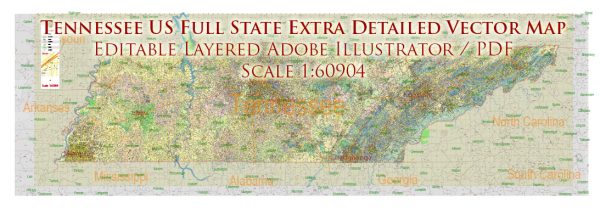Tennessee is a diverse state located in the southeastern United States. Its ecological description encompasses a wide range of landscapes and ecosystems, making it a region of great ecological significance. Here are some key features of Tennessee’s ecology:
- Geographic Regions: Tennessee can be broadly divided into three main geographic regions:
- East Tennessee: The Appalachian Mountains dominate this region, with rugged terrain, deep valleys, and numerous rivers and streams. The Great Smoky Mountains National Park is a significant natural area in East Tennessee.
- Middle Tennessee: This region is characterized by rolling hills and fertile valleys, with the Cumberland Plateau to the west and the Highland Rim to the east. It features a mix of forests, farmland, and urban areas.
- West Tennessee: This part of the state is flatter and more dominated by the Mississippi River. It includes the Mississippi Alluvial Plain and is known for its rich farmland and wetlands.
- Forests: Tennessee boasts a variety of forests, including hardwood deciduous forests in the east and mixed pine and hardwood forests in the west. The state is known for its beautiful fall foliage, with trees like oaks, maples, and hickories showcasing vibrant colors.
- Wildlife: Tennessee is home to a diverse array of wildlife, including white-tailed deer, black bears, wild turkeys, bobcats, and numerous bird species. The state is a critical part of the eastern flyway for migratory birds.
- Rivers and Streams: Tennessee is crisscrossed by numerous rivers and streams, including the Tennessee River, Cumberland River, and Mississippi River. These waterways support a variety of aquatic life and provide important habitats for both resident and migratory species.
- Wetlands: Wetlands are vital ecosystems in Tennessee, especially in the western part of the state. They provide habitat for waterfowl, amphibians, and numerous fish species.
- Caves and Karst Topography: Tennessee is home to a complex karst topography with a network of caves, sinkholes, and underground rivers. The state is famous for its caves, including the extensive cave systems in places like Cumberland Caverns and the Great Smoky Mountains.
- Biodiversity: Tennessee’s ecological diversity is a result of its varied landscapes and climates. It is home to a wide range of plant and animal species, some of which are unique to the region.
- Threats and Conservation: Like many states, Tennessee faces environmental challenges such as habitat loss, water pollution, and invasive species. Conservation efforts are in place to protect and restore the state’s natural resources.
Tennessee’s rich and varied ecology makes it a valuable region for conservation and outdoor recreation, with numerous parks, wildlife reserves, and natural areas for residents and visitors to enjoy.


 Author: Kirill Shrayber, Ph.D.
Author: Kirill Shrayber, Ph.D.